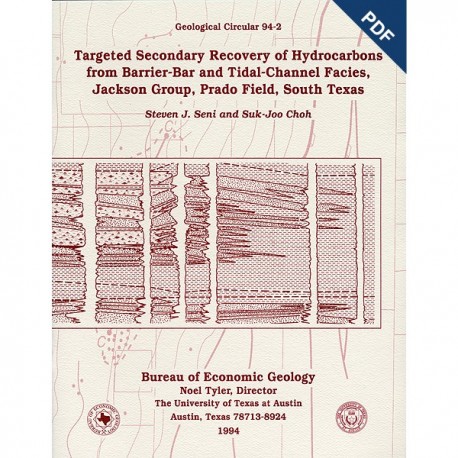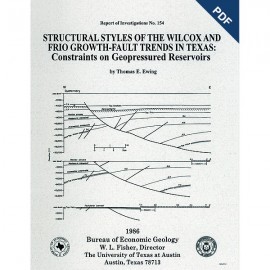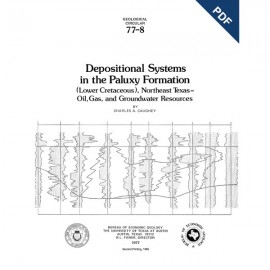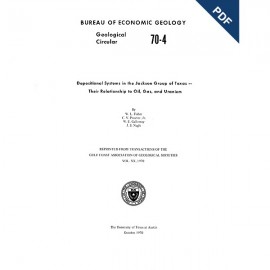Geological Circulars
-
Books & Reports
- Reports of Investigations
- Guidebooks
- Udden Series
- Geological Circulars
- Down To Earth
- Atlases of Major Oil and Gas Reservoirs
- Texas Memorial Museum Publications
- Environmental Geologic Atlas of the Texas Coastal Zone
- Mineral Resource Circulars
- Other Reports
- Seminars and Workshops
- Handbooks
- Submerged Lands of Texas
- Symposia
- Annual Reports
- Open File Reports
-
Maps & Cross Sections
- Thematic Maps
- Miscellaneous Maps, Charts & Sections
- Geologic Atlas of Texas
- STATEMAP Project Maps
- Geologic Quadrangle Maps
- Cross Sections
- Highway Geology Map
- Energy and Mineral Resource Maps
- Shoreline Change and Other Posters
- Wilcox Group, East Texas, Geological / Hydrological Folios
- Bouguer Gravity Atlas of Texas
- River Basin Regional Studies
- Featured Maps
- Posters
- Teachers & the Public
-
Geological Society Publications
- Gulf Coast Association of Geological Societies
- Alabama Geological Society
- Austin Geological Society
- Corpus Christi Geological Society
- Houston Geological Society
- Lafayette Geological Society
- Mississippi Geological Society
- New Orleans Geological Society
- South Texas Geological Society
- GCS SEPM Publications
- Historic BEG & UT Series
Targeted Secondary Recovery of Hydrocarbons from ...Prado Field, South Texas. Digital Download
GC9402D
For a print version: GC9402.
GC9402D. Targeted Secondary Recovery of Hydrocarbons from Barrier-Bar and Tidal-Channel Facies, Jackson Group, Prado Field, South Texas, by S. J. Seni and S.-J. Choh. 47 p., 21 figs., 1 table, 2 appendices, 1994. doi.org/10.23867/gc9402D. Downloadable PDF.
To purchase this publication in book format, please order GC9402.
ABSTRACT
Low recovery efficiencies of sandstone reservoirs in the Jackson-Yegua Barrier/ Strandplain Sandstone play mark it as a large hydrocarbon resource target for advanced recovery techniques. Prado field, Jim Hogg County, South Texas, has produced more than 23 million barrels of oil and more than 32 billion cubic feet of gas from structural-stratigraphic traps in barrier/strandplain sandstones of the Eocene lower Jackson Group. Recovery efficiency is 34 percent from the primary oil reservoir and 72 percent from the primary gas reservoir. To evaluate depositional and structural controls on hydrocarbon accumulation in Prado field and to determine the field's potential for geologically targeted reexploration, we analyzed well logs and engineering data. Excellent prospects for successful field reexploration are based on reservoir pressures and indications of undrained reservoir compartments. Hydrocarbon entrapment at Prado field resulted from anticlinal nosing by differential compaction and updip pinch-out of barrier/strandplain sandstone. Relative base-level lowering caused forced regression that established lower Jackson shoreline sandstones in central Jim Hog County 15 mi downdip from their former position. Subsequent progradation caused the barrier/strandplain system to build seaward 1 to 2 mi. Reservoir sandstone bodies at Prado field comprise complex assemblages of barrier-bar, tidal-inlet-fill, back-barrier-bar, and shoreface facies. Two findings in this study have regional application to exploration in the Jackson-Yegua and Frio Barrier/Strandplain Sandstone plays: (1) a regionally significant forced regression has locally shifted shoreline deposits basinward, where they are typically encased in mudstone, and (2) tidal-inlet and transgressive-barrier facies are geologically complex and thus have high potential for undrained hydrocarbon-bearing compartments.
Keywords: barrier/strandplain depositional systems, hydrocarbon play, Prado field, secondary recovery, South Texas, Texas Gulf Coastal Plain, Texas
Citation
Seni, S. J., and Choh, S-J., 1994, Targeted Secondary Recovery of Hydrocarbons from Barrier-Bar and Tidal-Channel Facies, Jackson Group, Prado Field, South Texas: The University of Texas at Austin, Bureau of Economic Geology Geological Circular 9402D, 47 p.






